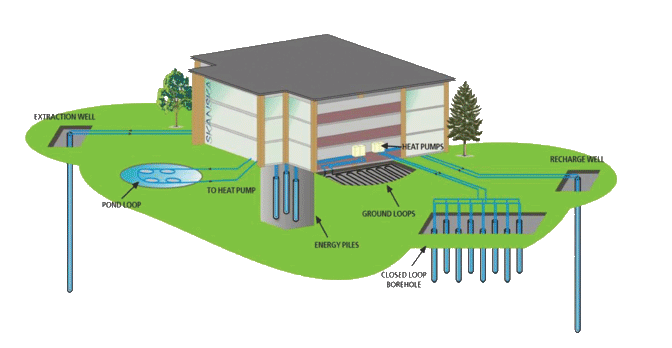Heat Pump
History of the heat pump
The history of the heat pump is closely aligned with the history of modern refrigerants. Some people would claim that the history of the heat pump begins in Scotland with Lord Kelvin and his theory on the Joule-Kelvin effect. The technology of heat pumps as they are recognised today were first widely used for space heating and hot water in Scandinavia and in particular Sweden. Sweden has been using and improving the technology since the energy crisis in the 1970s and where it was initially a pioneer for the technology it is now home to a lot of companies that are leading figures in the heat pump market. Since then the technology has been developed to become a mainstream supplier of heat energy to many households and businesses in Sweden and throughout the world.
Basic Concepts
Heat pumps extract solar energy stored in the ground, water or air which are collectively known as heat sources and supply it to another area of demand usually known as a heat sink. They take low temperature heat from the source and upgrade it to a higher temperature heat for the area demanding heat. It can be used to provide heating or cooling.
Heat pumps use the thermodynamic principals involved in heat transfer to move heat energy from the source to the sink. To do this they need to use a refrigerant or working fluid inside the heat pump. This fluid is used to transfer the heat from the source to the sink via a number of heat exchangers. CO2 is a natural refrigerant that is becoming more popular due to its minimal environmental impact and thermodynamic properties (to learn more about the CO2 cycle click here ).

Sources of Ground Heat
Heat sinks
- Space heating
- Underfloor heating
- Radiators
- Vented air
- Space cooling
- Domestic hot water(DHW)
Heat source
- Ground source
- Borehole, open loop or closed loop
- Slinky coil
- Piles
- Groundwater, ponds, lochs etc
- Air source
- Exhaust air
- Outdoor air
In basic terms
Air-source heat pumps remove solar energy from the air by sucking in and blowing the air across a heat exchanger or evaporator. As the air passes across the evaporator it passes over a set of plates and fins which contain a refrigerant usually at a much lower temperature than the outside air. Some of the heat stored in the air transfers to the refrigerant and the air is then blown back out of the other side of the heat pump unit slightly colder than when it entered. The refrigerant will then be compressed to a much higher pressure and temperature. It then passes across another heat exchanger where it transfers its heat to another fluid, usually water which then feeds a hot water tank.
The performance of heat pumps is measured by its COP value which stand for coefficient of performance. This is a measurement or ratio between the amount of energy used and the useful energy produced by the system. COP is equal to the amount of heat energy produced and delivered by the heat pump over the energy required to drive the pumps and compressor.















